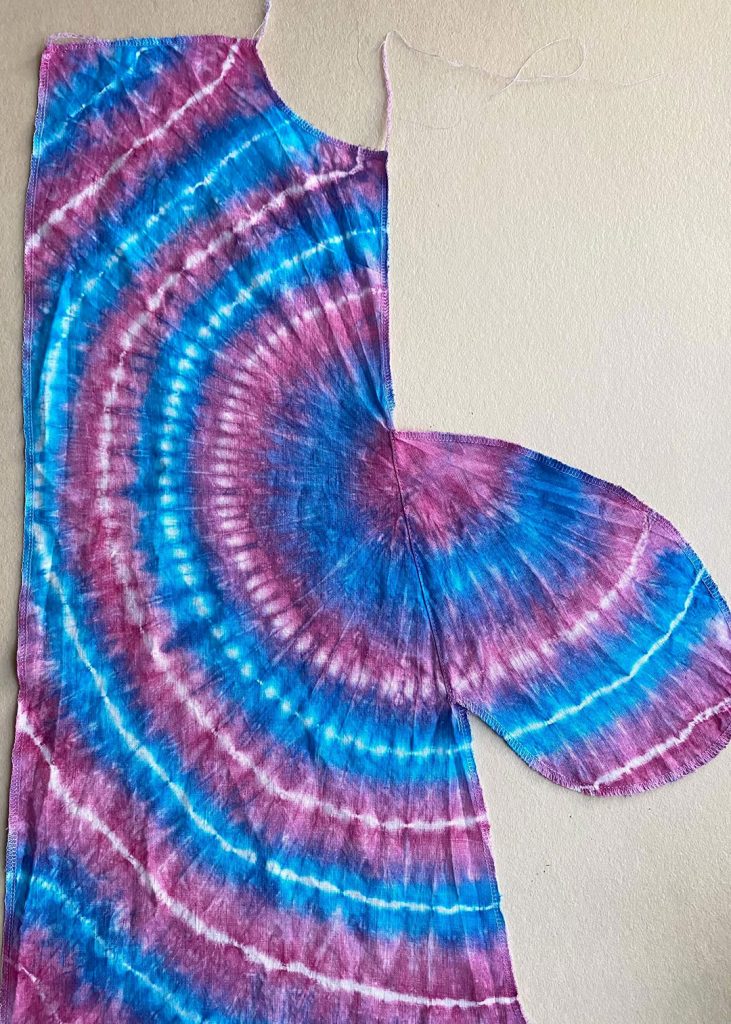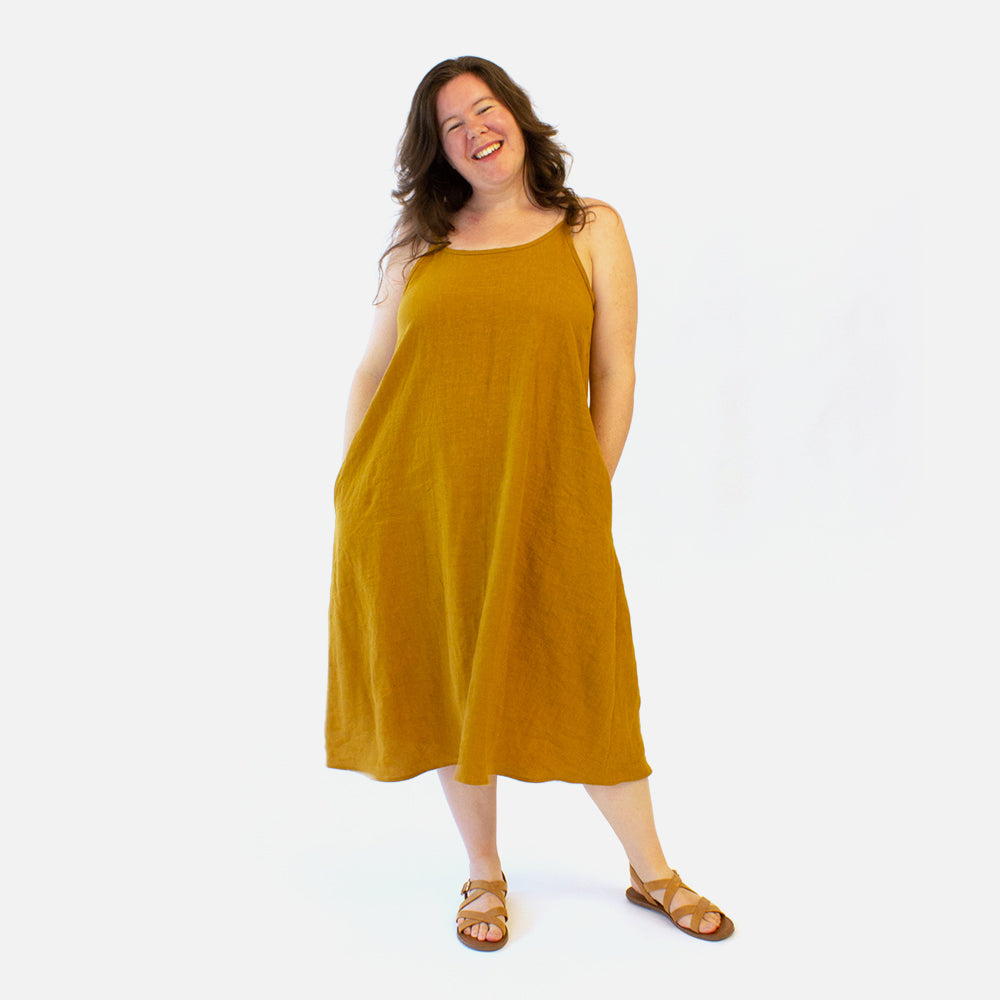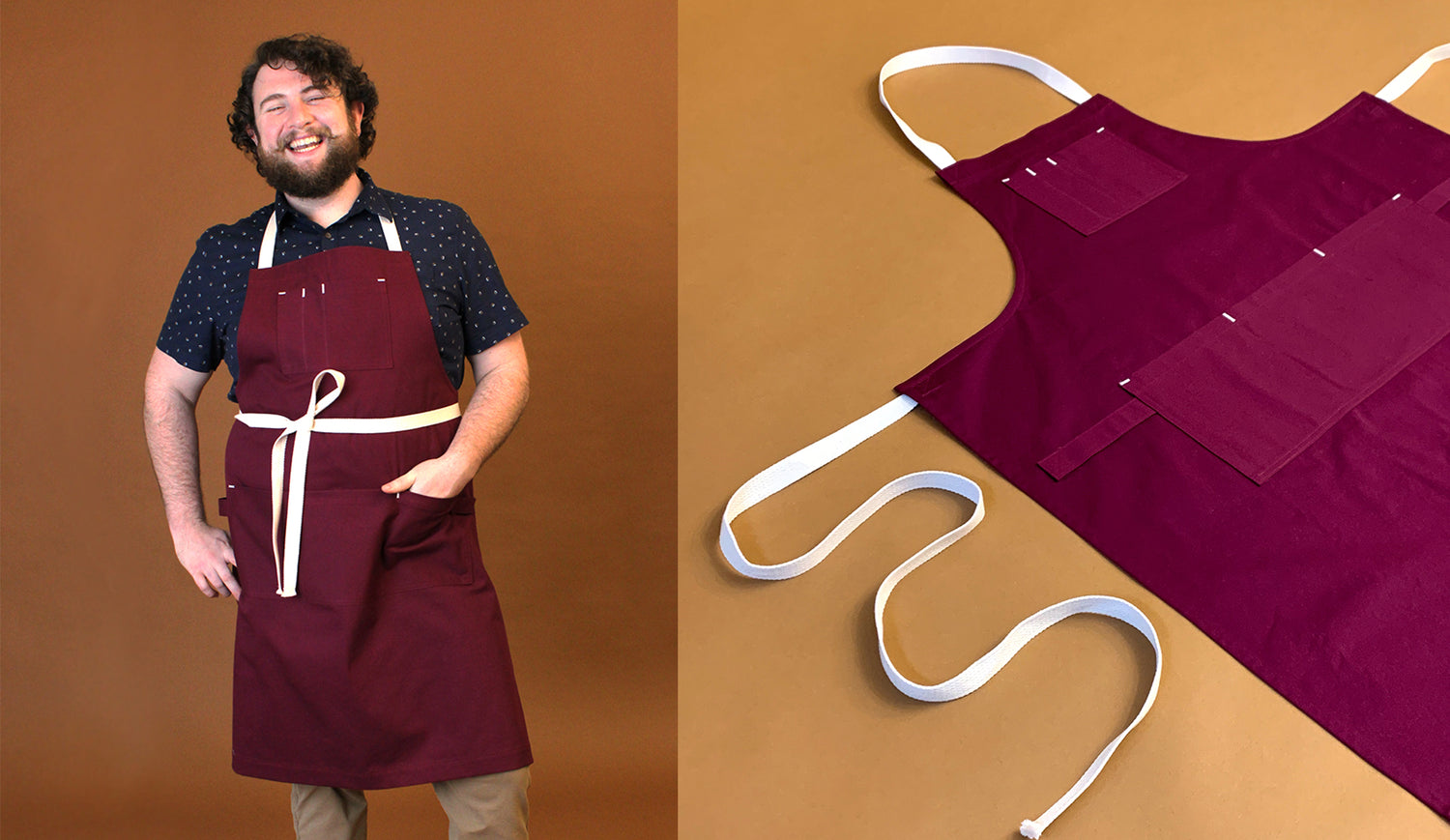Welcome back to Part 4 of Geri's Tie-Dye takeover on our blog! We have just one installment left before Geri reveals her incredible final Reynolds Dress. She's already covered the crumple, amoeba, bullseye, circle, and spiral tie-dye techniques. Today, Geri is going to show us how to achieve the fan fold pattern! Read on to learn how.

4th Installment - Fan Folding
The tie-dye technique that we are going to focus on in this 4th installment of the series is fan-folding. The picture above shows a sneak peak of my final Reynolds Dress, in which the right front panel is dyed with this technique. The following picture shows two close-ups of this fan-fold pattern:
On closer inspection, you can see the folds of the fan and the lines of the bindings, which are clearly defined by the white circular lines on the fabric.
To learn how to create a center front seam on the Reynolds Top and Dress, as well as how to prepare the fabric pieces for dyeing, please refer back to the 1st installment of this series. If you are a beginner at tie-dyeing, it is best to visit this post first before continuing here, since I also go into detail about how to set up a workstation.
Basic Materials and Tools Required For Dyeing:

- Rit All-Purpose Liquid Dye in your chosen colors
- Rit ColorStay Dye Fixative
- Squeeze bottles, with a volume of 125ml or 250ml. I use the smaller bottles for the colors and the larger one for the ColorStay Dye Fixative.
- Measuring cup and measuring spoons
- Large wire rack
- Large plastic container that the wire rack can sit on
- Large plastic sheets/covers or dollar-store shower curtains to protect your work surface
- Salt for cotton, linen, rayon, viscose; vinegar for silk and wool
- Gloves
- Plastic wrap
- Microwave-safe container or microwave-safe plastic bag
- Spray bottle to dampen the fabric
- Paper towels to keep things tidy
- Large pot to boil water
Fan-Folding Technique

Binding Tools:
- Sinew for tie-dye, string, or rubber bands
- Erasable or washable marker
Sinew for tie-dye is a polyester thread or string that is waxed, and it is commonly used for beading and leatherwork as well. It is sometimes referred to as artificial deer sinew, or simply waxed thread, string, or cord. I bought mine locally at a beading store, but it can also be found at craft stores, some haberdasheries or online at Amazon. It comes in a variety of colors, but I picked a neutral beige.
This is a very useful binding tool for tie-dye because it stays in place when pulled tightly, and you don’t have to tie a knot to keep it in place. Just wind it several times around the section of fabric you want to bind, pull tightly, and it will stay exactly where it is without unraveling. This it reduces the need to tie multiple knots, which is required when you are using regular string to bind. Most of the time, I find that it can bind fabric much more tightly compared to rubber bands or string. There is also zero risk of the waxed thread breaking while binding, as opposed to rubber bands, which may break when tied too tightly. Sinew is especially helpful when there are many thick layers of fabric to bind up.
As for the erasable or washable markers, take note that some may interact with the dyes or color fixative and become permanent on the fabric. To be safe, I recommend using a marker that is one of the colors in the palette you have chosen. You may also use Pilot Frixion Pens. These wash off completely and work quite well on dampened fabric.
Folding and Binding
Lay the fabric flat on your work surface with the right side facing up. Smooth out the creases and dampen it with a spray bottle. With an erasable or washable marker, mark the center of the fan-fold on your fabric.

Tie the end of a piece of string to the marker.

Place the other end of the string on the center mark that you’ve drawn on the fabric. Determine the radius of the circle you are drawing, and cut a length of string to match. Hold down the string at the center point with one hand. With the other hand move the tip of the pen around the center point in order to draw the circle for the fan-folds.

With your hands on the fabric, start at one end of the drawn circle, and move your fingers in a walking motion to pleat up the fabric into fan-folds or accordion folds. As you are pleating, line up the folds with the drawn circle as a guide.
Keep folding until you come to the other end of the circle.

Make a slip knot with the sinew. To make a slip knot, first make a loop and then pull another loop through the first loop you made.
Keep pulling until a slip knot is made. You will end up with a moveable slip knot, and a loop that can be pulled smaller or larger. Keep the other end of the sinew connected to the spool when you are binding the fabric.

Slip the loop over the pleated fabric and position the loop right over the drawn line. Pull the end of the sinew that is connected to the spool until the folds are securely bound together.

Wind the sinew at least 3 more times around the same spot, and pull tighter to firmly secure its position.

You may either secure this binding with a knot, or you may move up or down the length of the fabric to continue winding the fabric.

For me, I have decided I want more circular lines in my tie-dye pattern, going towards the center of the circle and away from this drawn circle line. So I've arranged the pleats that are closer to the center of the drawn circle, and repeated binding off sections with the sinew.
Tip: When you pull tightly on the sinew, use the palm of your hand to press firmly down on the wound up sinew, and then pull the sinew with the other hand. This will prevent you from cutting up your hands, especially when you want to bind the fabric very tightly.

I will continue binding the fabric this way down the length of the entire fabric piece. Make sure to arrange the pleats nicely before binding any sections off. At the other end of the fabric piece, I am rolling up the pleats into an optional spiral for some variation. I am binding this spiral with sinew, but not as tightly as I did in the circular sections.
If sinew is not available to you, then the fan-folds may be bound with rubber bands. Position the first rubber band over the drawn circle first, then continue binding off sections with more rubber bands throughout the length of the fabric. Once you’ve completed binding the fabric, end off with a knot to secure the bind.
I bound one of the panels for my daughter’s dress with rubber bands, so you can see the difference between binding with sinew and binding with rubber bands. We will view the results of both dye jobs towards the end of this post.
Once fully bound, the fabric is ready to be dyed.

Dyeing
The dyeing technique with squeeze bottles is the same one I detailed in the 1st installment of this series. Please refer back to that installment for tips on setting up the dye workstation. I am using squeeze bottles to apply the dye, since I am dyeing relatively small pieces of fabric.
The dye that I am using for this version of my Reynolds Top is Rit All-Purpose Liquid Dye in Aquamarine, Fuchsia, Violet and Indigo:

The two main colors that I am using for my dress are Aquamarine and Fuchsia. These two dyes interact to give darker shades of blue or purple, and that is why I am also using Violet and Indigo in very small amounts to highlight the color blend between Aquamarine and Fuchsia.
Dye Recipe:
The temperature of the water used for the dye solution should be at least 60 degrees Celsius or 140 degrees Fahrenheit. I prefer to work with water that is almost boiling when mixing the dyes. Usually before setting up my workstation and beginning the folding and binding, I will heat up a large pot of water so that it will be at the right temperature when I am ready to start dyeing.
- ½ tbsp salt
- 125ml (4 ¼ oz) of hot water
- Add at least ½ tbsp of dye color. You can intensify or darken the color by adding more dye. Use small fabric scraps or paper towels to do a quick color test.
Prepare the different dye colors separately in different squeeze bottles. I am using a small squeeze bottle with a smaller opening at the nozzle, so I am mixing the dye solution in a measuring cup before I pour it into the bottle. I find that the smaller the nozzle opening, the more precision there is when applying the dye.

When dyeing, keep in mind that oversaturation will cause the colors to blend and will reduce the overall contrast between them. It is always better to practice some restraint with dye application with a squeeze bottle, especially when you want to keep some white space left in the tie-dye design.
Because of how tightly the sinew binds up the fabric, I am expecting white lines to remain and be more clearly defined than when using rubber bands or string to tie up the fabric.
Position a large wire rack on top of a large container to catch the extra dye or fixative that drips into it. Position your fabric piece on the wire rack and start dyeing.
Basically, there is no right or wrong when applying the dyes here. Just be careful not to oversaturate. The different sections of the bound up fabric will produce concentric circles, so I like to alternate the colors between sections. In this case, I am not afraid to concentrate the dye at the bound areas, because I know the sinew binding is tight enough to resist the dye and prevent bleed.

Once one side is dyed, remember to flip it over and dye the corresponding sections with the same colors on the other side. Now the fabric is ready to be treated with ColorStay Dye Fixative.
ColorStay Dye Fixative:
After dyeing, immediately saturate the fabric pieces with ColorStay Dye Fixative.

ColorStay Dye Fixative Recipe:
- 250ml (8 ½ oz) of hot water in a squeeze bottle
- 2 tbsp of ColorStay Dye Fixative
Shake the bottle to mix well, then squirt the fixative all over the fabric pieces. Turn them over and saturate the pieces on the other side as well. Allow them to marinate in the fixative for at least 20 minutes.
Setting the Color & Washing Instructions:
To set the color, wrap up the fabric pieces in plastic wrap or cling film and place them in a microwave safe container or plastic bag. Then zap the bound fabric in the microwave oven for two minutes on the highest setting. Allow the fabric pieces to cool completely, then rinse them in cold water until the water runs clear. The rubber bands can be removed and the fabric unbound as you are rinsing it in the water. This is the magical moment when you get the first glimpse of the tie-dye patterns that you’ve created on the fabric.
Wash the fabric pieces quickly in warm water with detergent and without soaking. Either hang-dry out of direct sunlight, or dry them in the dryer. Remember that when wet the colors will appear darker than when dry.
Fan-Fold Tie Dye Result
Here is the resulting patterns from the fan-fold we did for these dress panels. On the left side is the one bound up with sinew, and on the right is the one bound up with rubber bands. As you can see, the sinew bind resists more dye than the rubber band bind, and therefore leaves more white patterning in the dyeing process. In addition, the sinew bind retains more accuracy with the intended drawn circle on the fabric. The white lines are more clearly defined, and the pleating pattern is accentuated as well.
For the last installment of this series we are going to create Mandala patterns, in which binding with sinew will be much more effective than other binding tools. I can’t wait to share the Mandala tie-dye technique with you. In the meantime, here is another sneak peak of my daughter’s completed dress. This time it’s the fan-fold pattern we created, used on the right front panel of her dress. See you soon for the next installment!





























